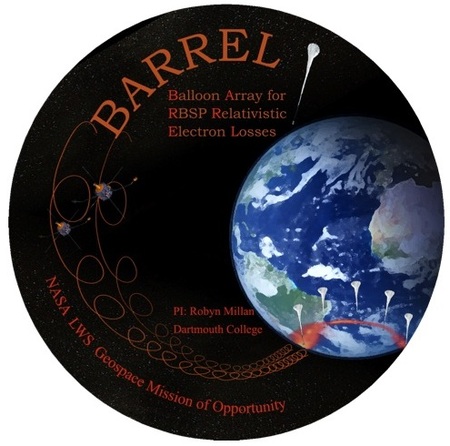BARREL
Balloon Array for RBSP Relativistic Electron Losses

BARREL is a NASA Mission that is operated by the Dartmouth Balloon Group that will work with the Radiation Belt Storm Probes (RBSP) launching balloons carrying scientific instrument suites from Antarctica in 2013 and 2014.
BARREL will help one of RBSP’s Mission Objectives which is to differentiate among competing processes affecting precipitation and loss of radiation particles by directly measuring the precipitation element. Radiation Belt Particles can enter Earth’s Atmosphere as they travel along the magnetic field lines to their base at the Poles producing X-Rays. This Loss of particles from the Radiation Belts is being monitored by the RBSP Spacecraft and by BARREL. The BARREL mission specifically looks at particles that break out of the belts and make it all the way to Earth’s atmosphere providing data on the spatial extent of the relativistic electron precipitation while RBSP can only monitor the general loss of radiation belt particles. Combining the two data sets on the same particles can improve understanding of the physics behind what drives such high-energy particles.
Each BARREL Instrument Suite has a mass of 25 Kilograms and is launched on a 9-meter balloon to float above Antarctica at an altitude of 36.5 Kilometers for several days by utilizing circumpolar winds. During the summer months at the South Pole, a circular pattern of slow moving winds sets up that can support the BARREL Mission by keeping the Payloads aloft for up to 10 days or longer – enabling each instrument to cover a large portion of the sky and increase the probability of BARREL catching events of interest.
When the RBSP Spacecraft detect an interesting particle-related event in the Van Allen Belts, BARREL can give feedback as to where the particles went. In total, there will be two one-month launching campaigns during which 20 balloons will be released with 1 or 2-day intervals. Campaigns are planned for January 2013 and 2014. Balloons will be launched from Alley Bay and the South African Antarctic Station.
Each Payload includes a 7.6 by 7.6-centimeter NaI scentilation detector that can measure X-Rays and Gamma-Rays in the energy range of 20keV to 10MeV. The detectors provide an energy resolution of 10% at 1MeV and a time resolution of 50ms in 4 energy channels. A solar power system supplies the payloads with 6W of electrical power. GPS technology is used to determine time and position. Telemetry and data transfer is accomplished via an Iridium Satellite link featuring a data rate of 2kbps. The instruments also include sun senors to determine orientation and direction of particle motion as well as a magnetometer measuring the horizontal and vertical magnetic field with a time resolution of 1 second. Via commanding from the ground, the Payloads can initiate a pyrotechnic separation charge that separates the instrument from the balloon. A parachute system is used during the return to the ground. This system can be used should any problems aboard the payloads occur or should a balloon come close to air traffic routes in case it is not caught by the circumpolar winds.
The BARREL Mission’s Principal Investigator is Robyn Millan at Dartmouth College. The University of Washington, U. C. Berkeley, and U. C. Santa Cruz are co-investigators that have contributed components of the Payloads. BARREL and RBSP are part of NASA’s living with a Star Program that is operated by the Goddard Space Flight Center.
BARREL Objectives:
- Determine electron loss rate during specific relativistic electron events measuring precipitation over a wide range of magnetic local times.
- Directly test models of wave-particle interactions by combining balloon measurements of precipitation with in situ RBSP measurements of plasma waves and particles
- Determine relative importance of different classes of precipitation
- Determine spatial extent and large-scale structure of precipitation.
